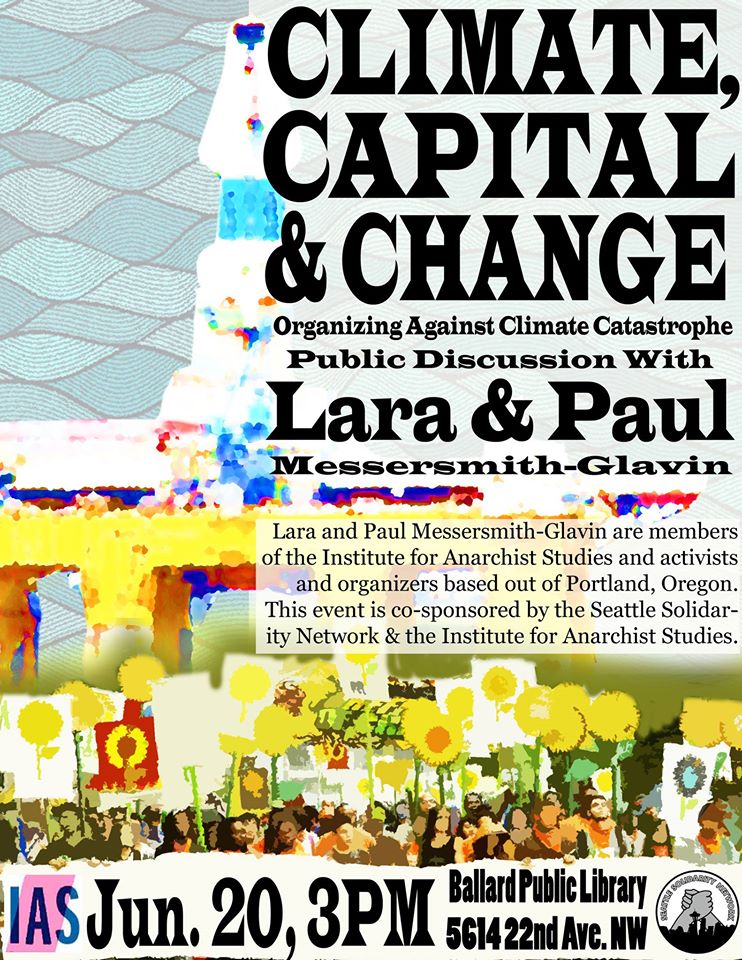I don’t know how to begin because I am no longer sure for whom I am writing. I am concerned that there is no longer an audience to write for.
As a necessary aside: with the disappearance of Left print media and the rise of blogs, there are few places left to publish. Journals with limited circulation or preselected audiences dominate the landscape and the contemporary radical media cannot reach fellow adherents, much less the larger public. Often, it seems that all that remains is a smattering of decrepit publications that speak for the ‘dead institutions’ of the American Left or function as the Daily Worker of a non-existent party — or, and possibly worse, blogs that only run the poorly written position papers of minuscule sects too self-obsessed to see their vanguardism coupled with, and only overshadowed by, their irrelevancy.
#Strategy
Climate, Capital and Change: Organizing Against Climate Catastrophe
Climate, Capital and Change: Lara and Paul Messersmith-Glavin on Organizing Against Climate Catastrophe
Saturday, June 20th, 3PM Ballard Library, SPL, 5614 22nd Ave NW, Seattle, WA
Organizing Against Climate Catastrophe, by Paul Messersmith-Glavin

The forces responsible for changing the climate and endangering the future of humanity have names. Names such as: Chevron and Exxon Mobil, Saudi Aramco and Petroleos de Venezuela. They are the predominant groups responsible for playing havoc with our collective future. In fact, two-thirds of historic carbon dioxide and methane emissions can be attributed to exactly ninety entities. They are based in forty-three countries and extract resources from every oil, natural gas, and coal rich region in the world. They process the fuels into products that are sold to consumers in every nation on the planet. Of the top 85 emitters, 54 are in industrialized countries and 31 are in developing nations.[2] Knowing who and where they are demonstrates that an end to the problem is within our reach. In order to stop global climate change all we need to do is put pressure on these isolated entities, right?
Wrong. While these are the primary economic forces responsible for climate change, it would be a mistake to think if we stop these particular companies from conducting business as usual, we can solve the problem. They are only the most public faces of a system that goes much deeper.
Ready to Fight: Developing a 21st Century Community Syndicalism by Shane Burley
Consistent with the ‘strategy’ theme of the current issue of Perspectives on Anarchist Theory (No. 27), Shane Burley lays out what the anarcho-syndicalist tradition offers movements outside the workplace.

There has been an effort by scholars and organizers alike over the last forty years to segregate anarcho-syndicalism from the rest of the broad anarchist movement. The labor movement dominated social struggles in the first half of the twentieth century, but as large business union bureaucracies were formed and new shop organizing began to diminish, the participation of anarchists in labor began to wane as community struggles around environmental issues, LGBT and women’s struggles, and housing justice took precedence. The syndicalist strategies that defined the earlier successes of anarchism internationally diminished to only the most hardcore adherents of a labor strategy, though these ideas have had spikes during periods of economic crisis. This shift away from syndicalism as a strategic foundation has robbed movements of some of their tactical inspirations, and organizers from the New Left forward attempt to reinvent the wheel every time, completely reimagining every struggle as though it was disconnected from the entire history of libertarian social movements. This is a loss as these developing community struggles can still look towards these syndicalist battles in the workplace as a model for how to democratically structure movements.
The idea of community syndicalism, bringing the syndicalist organizing strategy out of the workplace and into other aspects of life, can be a way to intentionally create a specific set of tactics. These tactical choices could take the form of solidarity structures that form as a union, which mean that they unite a set of interests against an adversary that is in control of a particular sector of society, such as labor, housing, or healthcare. These different sectors are the different puzzle pieces of social life that are all intimately affected by access to resources, and one in which a real element of class is present at all times. Since syndicalism in the workplace does not rely on simply one tactic, but instead on the use of solidarity, trying to utilize community syndicalism could simply mean a whole range of strategic points all building on some of the basic ideas of anarcho-syndicalism. The question then arises: what are the core elements of anarcho-syndicalism that can be boiled down and moved from the shop floor to the neighborhood, from workers issues to healthcare and environmentalism, and to all the sectors where class struggle takes place?

